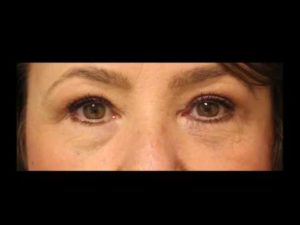February 7, 2011
Written By:
Dr. Edwin Williams
Dr. Edwin Williams is the founder of The Williams Center and a double board-certified facial plastic surgeon who has completed over 10,000 surgical procedures.
 Blepharoplasty, also known as eyelid surgery, is a facial plastic surgery procedure designed to correct droopiness and wrinkling of the upper eyelids along with puffy under eye bags. This is achieved by removing excess fat, skin and muscle or volumizing with fat transfers. Blepharoplasty may be performed on the upper eyelids, the lower eyelids, or both. Good candidates for blepharoplasty include men and women who are physically healthy, realistic in their expectations, and looking to improve the appearance of puffy under eye bags or drooping of the upper eyelids. Click here to see Before and After photos.
Blepharoplasty, also known as eyelid surgery, is a facial plastic surgery procedure designed to correct droopiness and wrinkling of the upper eyelids along with puffy under eye bags. This is achieved by removing excess fat, skin and muscle or volumizing with fat transfers. Blepharoplasty may be performed on the upper eyelids, the lower eyelids, or both. Good candidates for blepharoplasty include men and women who are physically healthy, realistic in their expectations, and looking to improve the appearance of puffy under eye bags or drooping of the upper eyelids. Click here to see Before and After photos.
Click Here to view video

Drooping of the upper eyelids is referred to as ptosis. Eyelid ptosis usually occurs when the muscle of the upper eyelid is not strong enough to raise the eyelid. Mild ptosis is considered a cosmetic procedure. More severe ptosis repair can be covered by insurance. To determine whether this is a covered procedure you would have to have a field of vision study done to determine if this is a medically necessary procedure. Click here to view Before & After photos of Ptosis repair.
About the Blepharoplasty Surgery
Eyelid surgery typically takes between one and two hours to complete and may be performed in a surgeon’s office-based facility, an outpatient surgery center such as New England Laser and Cosmetic Surgery Center, or a hospital. Local anesthesia with sedation is often used, though general anesthesia may also be used. Incisions tend to be well-concealed, being located in the fold of the eyelid for the upper eyelids and inside of the lower eyelid for the lower eyelids. Once the incisions are made, excess fat is removed and sagging skin and muscle may be trimmed. If excess skin needs to be removed from the lower eye lids fine sutures are then used to close the incisions. For further tightening of the skin a chemical peel may be applied to skin on the lower lids.
Each patient is carefully evaluated to ascertain the procedure of choice. Volumizing the areas under the eyes and brow is yet another option accomplished with fat transfers. Fat transferred can be preformed alone or in conjunction with convectional Blepharoplasty.
The Sliver Technique
Dr. Williams performs what he calls the “Sliver Technique” on either the upper and/or lower eyelids. The purpose of this procedure is to remove loose, excess skin. This excess skin can give one the appearance of aging or looking tired all of the time. This is an office procedure that can be performed under local anesthesia, similar to going to the dentist.  Click to watch video
Click to watch video
A fine incision is made in the upper eyelid’s crease or, in the lower eyelid, just under the eyelashes. A small amount of excess skin is removed and sewn together with a very fine suture. The sutures are removed in about 6 days. Bruising and swelling is common and lasts about a week, but, for some patients, longer. This bruising can typically be camouflaged with makeup at around the 8 day mark, if still present. It is important to keep in mind that everyone heals differently. Patients will typically take Tylenol for any discomfort they may have. Instructions are given to the patient on how to care for their incision lines, how often to apply ice and to keep their head elevated for the first few nights while sleeping. As long as the patient does not request oral sedation they are able to drive themselves home.
Blepharoplasty Surgery Recovery Information
After eyelid surgery, some tightness and soreness of the eyelids can occur and may be controlled with prescription pain medication. Patients should keep the head elevated as much as possible during the first few days and regularly apply cold compresses to help reduce swelling and bruising. Dryness, itchiness, burning, excessive tearing, sensitivity to light, and blurred or double vision can occur during the first week. It typically takes ten days for the bruising to fade. Patients can usually resume reading within two to three days, and the stitches will be removed within six days. Work and most normal activities may be resumed within seven to ten days, while contact lenses may be worn after two or more weeks. More strenuous activities and alcohol consumption should be avoided for about three weeks.
Dr. Williams will discuss with you during your inital consultation any potential complications that may occur with eyelid surgery are as follows: bleeding, difficulty in completely closing the eyes, dry eyes, infection, pulling down of the lower lids, slight asymmetry in healing or scarring, swelling at the corners of the eyelids, temporary blurred or double vision, and whiteheads.
While the blepharoplasty procedure rejuvenates the eyes, the facelift can erase the signs of aging in the entire face. Also, if you are considering treatment for both your eyelids and brow and or forehead, the browlift can elevate the position of the eybrows and reduce the lines and wrinkles in the forehead.
Schedule a consultation to learn about how blepharoplasty can rejuvenate your eyelids by calling our New York office at (518) 786-7000.
Read More


 Blepharoplasty, also known as eyelid surgery, is a
Blepharoplasty, also known as eyelid surgery, is a 
 One of the first signs of aging is facial sag and a droopy nose tip which can make a person appear as though their nose has actually grown longer.
One of the first signs of aging is facial sag and a droopy nose tip which can make a person appear as though their nose has actually grown longer.